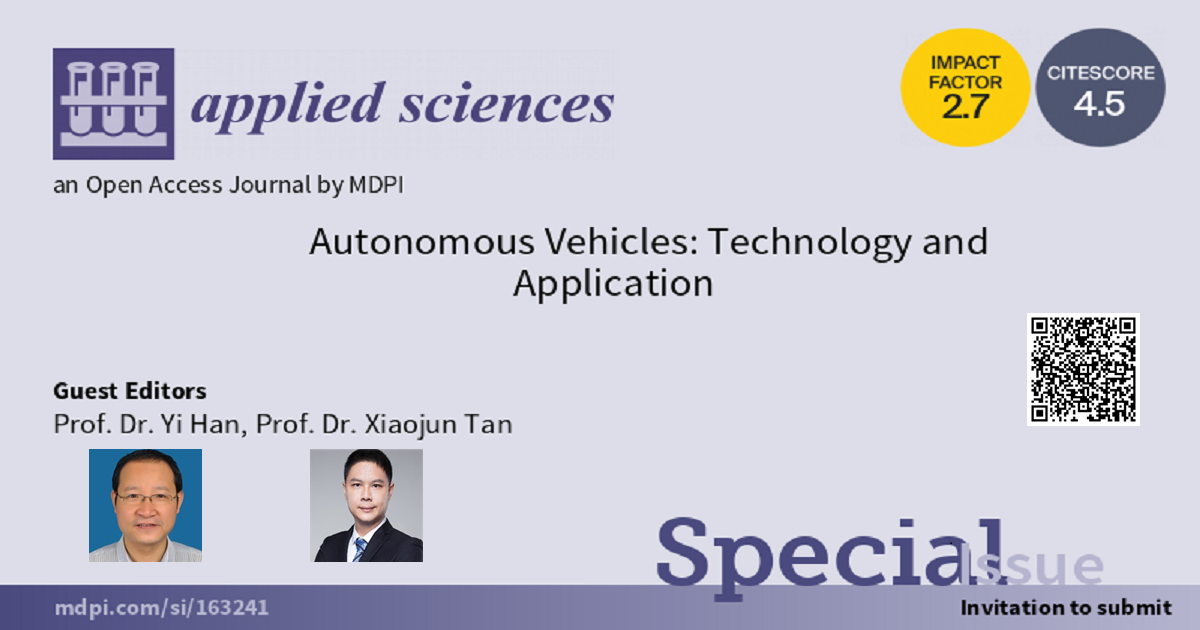Autonomous Vehicles: Technology and Application
A special issue of Applied Sciences (ISSN 2076-3417). This special issue belongs to the section "Transportation and Future Mobility".
Deadline for manuscript submissions: 30 June 2024 | Viewed by 13259

Special Issue Editors
Interests: new energy vehicles; autonomous vehicles
Interests: new energy vehicles; smart driving; cluster control for unmanned systems application; computer vision and its application technology
Special Issues, Collections and Topics in MDPI journals
Special Issue Information
Dear Colleagues,
We invite submissions to this Special Issue devoted to the technology and application of autonomous vehicles. Driverless driving helps improve traffic safety and efficiency, which is a hot topic in the development of artificial intelligence technology and intelligent transportation technology. Its aim is to drive more safely and reliably, free people's hands, and reduce physical labor. In the process of driving, people are the most uncertain factors, and the autonomous car works according to the computer control set by people, which can greatly reduce the occurrence of accidents, to a certain extent, while freeing hands. In general, driverless technology is a synthesis of many cutting-edge disciplines such as sensors, computers, artificial intelligence, communications, navigation and positioning, pattern recognition, machine vision, and intelligent control. According to the functional modules of driverless cars, the key technologies of driverless cars include environmental awareness, navigation and positioning, path planning, and decision control. In recent years, with the maturity of unmanned driving technology, the application and industrial system of the low-speed unmanned driving market have begun to see a larger scale. Semi-closed places with logistics transportation and personnel transfer have gradually become a typical application scenario where functional low-speed unmanned vehicles can quickly land. The application of unmanned driving will have a disruptive impact on the industry and encourage and promote the progress and technological upgrading of vehicle manufacturers.
For this Special Issue, we invite submissions exploring cutting-edge research and recent advances in the fields of autonomous vehicles. Both theoretical and experimental studies are welcome, as well as comprehensive reviews and survey papers.
Prof. Dr. Yi Han
Prof. Dr. Xiaojun Tan
Guest Editors
Manuscript Submission Information
Manuscripts should be submitted online at www.mdpi.com by registering and logging in to this website. Once you are registered, click here to go to the submission form. Manuscripts can be submitted until the deadline. All submissions that pass pre-check are peer-reviewed. Accepted papers will be published continuously in the journal (as soon as accepted) and will be listed together on the special issue website. Research articles, review articles as well as short communications are invited. For planned papers, a title and short abstract (about 100 words) can be sent to the Editorial Office for announcement on this website.
Submitted manuscripts should not have been published previously, nor be under consideration for publication elsewhere (except conference proceedings papers). All manuscripts are thoroughly refereed through a single-blind peer-review process. A guide for authors and other relevant information for submission of manuscripts is available on the Instructions for Authors page. Applied Sciences is an international peer-reviewed open access semimonthly journal published by MDPI.
Please visit the Instructions for Authors page before submitting a manuscript. The Article Processing Charge (APC) for publication in this open access journal is 2400 CHF (Swiss Francs). Submitted papers should be well formatted and use good English. Authors may use MDPI's English editing service prior to publication or during author revisions.
Keywords
- autonomous vehicles
- new energy vehicles
- cluster control for unmanned systems application
- computer vision
- smart driving






